Slope Strategies: Senior Skiing Essentials
Adjusting Techniques for Older SkiersSkiing offers a thrilling experience, but older skiers face challenges. Aging alters our bodies, making technique adjustments vital for safety and enjoyment. This guide helps older skiers enhance their experience on the slopes.
Understanding the Changes
Aging affects balance, flexibility, and strength. These changes impact skiing performance. Older skiers may struggle to bend their knees or maintain balance. Joint stiffness and decreased muscle mass hinder dynamic movements. Therefore, adjusting skiing techniques is crucial.Older skiers might also experience slower reaction times. This can complicate navigating challenging terrain and increase fall risks. Understanding these changes helps skiers adapt their techniques and encourages a cautious approach.
Tips for Adjusting Techniques
As an Amazon Associate I earn from qualifying purchases.
Gear tip: consider ski goggles, ski helmet, and ski gloves to support this topic.
1. Focus on Balance
Balance plays a pivotal role in skiing for older skiers. Maintain a low center of gravity to enhance stability. Slightly bend your knees and lean forward to improve balance. This position allows better control and responsiveness to terrain changes.To enhance balance, practice exercises off the slopes. Simple activities like standing on one leg can improve stability. Use balance boards or stability balls in your fitness routine. Yoga and Pilates strengthen the core and improve flexibility, essential for skiing.
2. Use Proper Equipment
Choosing the right equipment is vital for older skiers. Select skis that match your skill level and physical condition. Shorter, wider skis offer stability and maneuverability, making them ideal. Softer boots provide comfort and ease of movement, reducing leg strain.Don’t overlook ski poles, which assist with balance and support. Adjust the pole length to fit your height for a comfortable grip.
3. Take Breaks
Rest is essential for maintaining energy and focus. Skiing can be demanding, and fatigue increases accident risks. Take regular breaks to recharge. Listen to your body and stop when tired; pushing through exhaustion raises injury risks.Use breaks to hydrate, snack, and stretch. This practice prevents injuries and enhances your overall skiing experience.
Advice for a Safer Experience
1. Ski with a Buddy
Skiing with a partner enhances safety and enjoyment.
Conclusion
Adjusting techniques allows older skiers to enjoy skiing safely and effectively. Follow these tips to enhance your experience on the slopes.
Below are related products based on this post:
FAQ
Why is it important for older skiers to adjust their techniques?
Aging affects balance, flexibility, and strength, which can hinder skiing performance. Adjusting techniques is crucial for safety and enjoyment, helping older skiers navigate the slopes more effectively.
What are some tips for improving balance while skiing?
Maintaining a low center of gravity is essential for stability. Older skiers should slightly bend their knees and lean forward while skiing, and they can also practice balance exercises off the slopes, such as standing on one leg or using balance boards.
How can proper equipment impact older skiers’ performance?
Choosing the right equipment is vital for comfort and safety. Shorter, wider skis provide stability, while softer boots reduce leg strain. Additionally, using properly adjusted ski poles can assist with balance and support on the slopes.















Post Comment